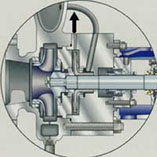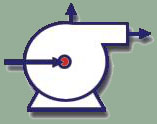 "Multiplicity ought not to be posited without necessity." — Occam's Razor Otherwise stated: |
A Life Well Traveled:Igor J. Karassik (1911-1995) By J. T. (Terry) McGuire
Before discussing Igor Karassik and what he did, it’s important to recognize that he endorsed the International Pump Users Symposium wholeheartedly, and participated in it frequently and with great enthusiasm, as was his way. He did this because its objective, to help pump users better understand pumps, followed a fundamental premise of his participation in the pump industry. Early in his career, Karassik determined that a manufacturer of machinery will have the greatest chance of success when the company’s objective is to help its customers succeed in their endeavors. This philosophy was evident in Karassik’ s frequent observation that “Operators deserve to sleep nights too!” To better understand Igor Karassik and his achievements, it’s necessary to recount some of his background. The circumstances of his childhood and adolescence. He was born in Russia; fled the revolution; he had a classical education and spoke three languages. Karassik developed a character possessed of compassion for his fellow man; he had great curiosity, and a generous sense of humor. Though English was not his native tongue, Karassik developed a masterly command of the language, allowing him to speak or write with ease on a wide range of subjects to just about any audience. In keeping with most who achieve great prominence in their chosen endeavor, Igor Karassik’s life and work were largely one and the same. Karassik contributed to the pump industry with an elegant meld of technical development, commercial reality, and education. His professional career started with Worthington in 1936. Fortunate to have excellent mentors, he quickly acquired the elements of the “art” as it was, then proceeded to improve it. Notable among the technical developments he was associated with are: • In conjunction with George F. Wislicenus and R.M. Watson in 1937, the development of suction-specific speed, the dimensionless relationship between flow, rotative speed, and the NPSH required. This relationship was sought in order to overcome the limitation of the Thoma-Moody constant, which related head to NPSH required. • Working with Pacific Gas & Electric and Bechtel, starting in 1946 and publishing in 1953, the means of preventing catastrophic boiler feed pump failures during sudden load reductions in open-cycle steam power plants. Widely attributed to poorly designed antiflash baffling, the cause of these failures turned out to be an apparent paradox: The volume of the suction piping had to be less than a certain fraction of the deaerator storage volume to ensure there was no flashing at the boiler feed pump. • With Public Service Electric & Gas as an ally, the installation in 1953 of a prototype 9,000 rpm boiler feed pump. Concerned that one consequence of increasing operating pressures of steam power plants was declining reliability of the 3,600 rpm boiler feed pumps then in use, a result of more stages to develop the required head, hence more flexible rotors, Karassik began promoting the concept of the high speed boiler feed pump. Running at 2.5 times the then maximum speed to develop 1,500 ft (550 m) head per stage, thereby lower the number of stages, the high speed boiler feed pump was controversial within the utility industry. Following a redesign of its inner casing to correct internal leakage, the prototype pump gave a good account of itself. For the following seven years, Karassik and his company had the advantage of being the only manufacturer of high speed boiler feed pumps. It was this technology that in 1956 allowed the design of first pump to develop the head required for a 3,500 psig (240 bar) supercritical boiler in a single casing, thereby avoiding the need for split pumping (two pumps in series), a complex and frequently troublesome arrangement. • In 1972 with W.H. Fraser and Austin R. Bush co-authored a qualitative explanation of serious operating problems that were occurring in high energy pumps when operated at capacities much below design. The authors argued that the problems of noise, vibration, suction pressure pulsations, premature impeller erosion, and even impeller shroud fracture, were all attributable to recirculation within the impeller and could be overcome with the appropriate impeller design. Despite references in the literature to such a phenomenon, Carrard, in 1923, and Wislicenus, in 1947, to name two, many in the industry were skeptical of the explanation. Subsequent experience, however, has shown that Karassik and his colleagues understood the problem. • While manager of Worthington’s Pioneer Products group in the 1970s, a number of novel machines, among them: a close-coupled, steam turbine driven compressor running at 41,750 rpm on water lubricated bearings; a water turbine driven pump with the turbine runner an integral part of the impeller; a catamaran, the “Mop Cat,” for recovering oil spills from waterways; and an injection molded plastic pump designed for mass production. Thirty years ago, Karassik raised the idea of hermetically sealed, integral motor boiler feed pumps. These machines are yet to come, but hermetically sealed boiler circulating pumps are now in general use, and prototype canned motor pumps with their rotors supported by magnetic bearings have been built and put into trial installations. Similarly, some 20 years ago, Karassik started advocating variable speed drive by frequency modulation. His justification for this was threefold: First, there was great merit in designing pumps for speeds other than the normal induction motor speeds. Second, varying pump speed to control flow usually saved energy. Third, frequency modulation allowed the use of regular induction motors, a simple and readily available device. Though used for very large and very small pumps for some time, variable frequency drive is just now starting to come into broad use as the means of controlling pump flow.
True to the central idea of his business philosophy, Igor Karassik promoted what would now be termed alliances as the most effective commercial relationship between two parties in any transaction. The essential aspect of these informal agreements was direct assistance with plant design to develop the optimum pumping arrangement (including new pump designs in some cases), with the final price being determined from a previously agreed listing or by negotiation for new designs. Two purchasers who chose to work on an alliance basis are Southwestern Public Service and Kaiser Engineers and Constructors, the former starting around 1938. Both derived apparent benefit; Southwestern Public Service achieving high availability and low operating costs with the units built using this arrangement, to the extent of winning a national award on two occasions for the lowest cost per kWhr.; and Kaiser building many plants that gave the owner the advantage of standardization of the make and type of pumps throughout the plant. The education aspect of Karassik’s contribution to the pump industry is best illustrated by a reflection he made toward the end of his life, namely that his life’s work could perhaps best be summarized as that of a teacher. Recognizing that no philosophy or innovation will succeed unless its virtues are adequately communicated, the reflection is accurate. Over his lifetime, Igor Karassik taught the basics of the pump industry and argued for his philosophy and innovations in more than 1,100 articles and papers, 4 books, and countless lectures, seminars, talks, and dinner table discussions. And in all this, the emphasis was on rendering the incomprehensible comprehensible rather than trying to impress all with his learnedness. Igor Karassik was unique, as is every human being, and therefore, will not be replaced by another like him. But recognizing what he did for his chosen profession and industry, it’s clear that our challenge is to pick up where he left off and try to do as well. That is a challenge by any standard, and it certainly reflects a life well travelled!
|
Split Flow™
Proceedings of the 13th International Pump Users Symposium, March 1996
Also in the Igor Karassik series:
Pump Users Symposium: A Name Well Chosen Smoke or Substance? Some Misconceptions About Desirable Construction Features of Centrifugal Pumps
|



 J.T. (Terry) McGuire is Director of Application and Contract Engineering
with Ingersoll Dresser Pump Company,Huntington Park, California. He has spent
all of his career to date in liquid handling turbomachinery, starting as an apprentice
draftsman with Worthington Australia in 1965. In 1973, he became Engineering
Manager, the position he held until moving to the United States in 1984. Since then, he has
held a series of engineering management positions in the Worthington
Operation of Dresser Pump at Harrison, New Jersey, and in Voith Hydro at York,
Pennsylvania.
J.T. (Terry) McGuire is Director of Application and Contract Engineering
with Ingersoll Dresser Pump Company,Huntington Park, California. He has spent
all of his career to date in liquid handling turbomachinery, starting as an apprentice
draftsman with Worthington Australia in 1965. In 1973, he became Engineering
Manager, the position he held until moving to the United States in 1984. Since then, he has
held a series of engineering management positions in the Worthington
Operation of Dresser Pump at Harrison, New Jersey, and in Voith Hydro at York,
Pennsylvania.